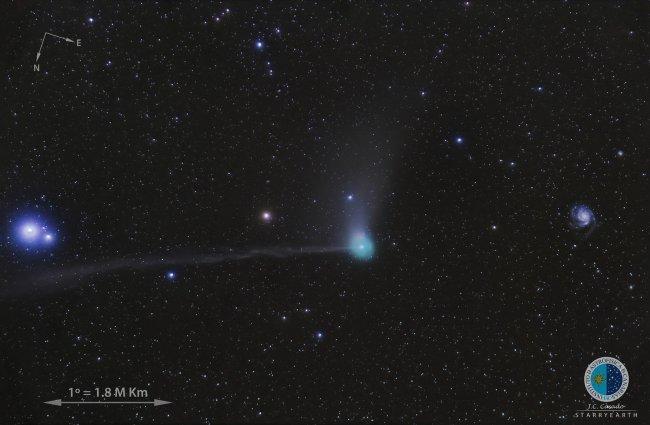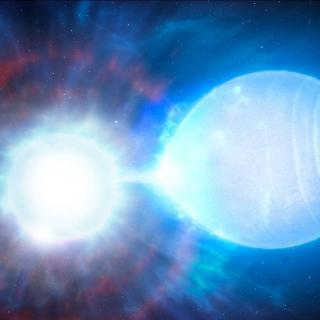The eyes of astronomers are fixed on this pair of comets which reach their perigee, the minimum distance from our planet, on March 21st and 22nd, to find out about the relation between them. It is believed that P/2016 BA14 (Pan STARRS) y 252P/Linear have a common origin because they are in almost identical orbits with comparable periods, 5.25 years and 5.32 years, respectively, according to observations by the astronomers from the University of Maryland, Michael Kelly and Matthew Knight.
Pan STARRRS passes perigee on Tuesday March 22nd at 16.00 Universal time, (UT, which is the same as Canary Island time, one hour more in the Peninsula), at only nine times the distance of the Moon from us, (3.5 million kilometres). Yesterday, March 21st, at 15.30 UT its companion 252P/Linear reached its perigee at 13 lunar distances from us. We need to refer back to the year 1770 to find a comet- in that case Lexell- which came as close to the Earth as PanSTARRS .
During its closest approach, which does not entail any threat to the Earth, PanSTARRS is under observation by optical and radio telescopes in order to discover the main characteristics of its nucleus. The Hubble Space Telescope be will also help to clear away its mysteries. The spectra, taken as they approach the Earth, will help us to tell whether they are related, although it is thought likely that PanSTARRS is a fragment of Linear, and it is quite possible that other “companions” will appear along the same orbit.
The optical telescopes at the Observatorio del Teide will be used to follow the comets. The clear Canarian skies allowed us to see the spectacle provided by comet Lovejoy towards the end of 2014 and comet Catalina a few months ago. Now we are awaiting the flying visit of PanSTARRS and Linear for the last weeks of March. As opposed to Lovejoy and Catalina, PanSTARRS and Linear are “veterans”, they have made frequent visits to the neighbourhood of the Earth and Mars, where they have been moving for the last few thousand years.
Who discovered them?
PanSTARRS was discovered on January 21st 2016 during a programme which scans the sky for asteroids and comets using Panstarrs (Panoramic Survey Telescope and Rapid Response System, on Hawaii, USA). It was first catalogued as an asteroid. It was the Russian astronomer Denis Denisenko who realized that the orbit of PanSTARRS was similar to that of comet 252P/Linear discovered in the year 2000. PanSTARRS stopped being an asteroid and became a comet with a companion.
What is a comet?
A comet is an object within our Solar System composed mainly of ice and dust, so that they have been nicknamed “dirty snowballs”. Comets move around the Sun on very elongated, normally elliptical, orbits, with periods (the time they take to go once around an orbit) which range from a few years to hundreds of thousands of years.
When they reach the point in their orbit nearest to the Sun (perihelion) the heat melts the ices of the comets, which emit gas and dust particles that form a tail, or tails of the comet. The tails can be more than a million kilometres long. The solid part of a comet is its nucleus which can be from 10 km to 40 km in size. The majority of comets come from the Oort cloud, a spherical cloud situated at around a light year from the sun, although some originate in the Kuiper belt, a disc of objects between 7,500 and 15,000 million kilometres from the Sun, which normally have short periods (less than 200 years). Because they can suffer gravitational disturbances by the giant planets (Jupiter, Saturn, Uranus, and Neptune) the comets from the Kuiper belt can fall into the inner part of the Solar System and form families. The comets of Jupiter’s family (named because they are under the primary gravitational influence of that planet), have short orbital periods of less than 20 years, and their orbits have low inclination, which means that the comet’s orbit is close to the plane of the orbits of the planets: the ecliptic plane. One of the most famous is comet 67P/Churyumov-Gersimanko, which is currently being studied by the European Rosetta mission.
From the astronomical point of view the study of comets is very interesting as they are fossils left over from the formation of the Solar System and so contain information about the formation of planetary systems. If, in addition, a comet comes from the Oort cloud (as was the case with Comet Catalina) the scientific interest is even greater because these are usually new comets, which contain primordial, unprocessed material form the original cloud which gave birth to the Solar System.
Audiovisual material
Orbit of comet PanSTARRS P/2016 BA14: https://www.youtube.com/playlist?list=PL6oc5e7lSjeIiXkwbCLS0ZGMNuFxF5Oui
Time- laps of comet on March 19th 2016: https://www.youtube.com/watch?v=2EuHq174RZw&feature=youtu.be
Video communiqué PanSTARRS: https://www.youtube.com/watch?v=THZECv3xIDY&feature=youtu.be
Scanned programme Panstarrs: http://pan-starrs.ifa.hawaii.edu/public/
Contact:
Miquel Serra-Ricart, investigador del IAC: mserra [at] iac.es (mserra[at]iac[dot]es)



